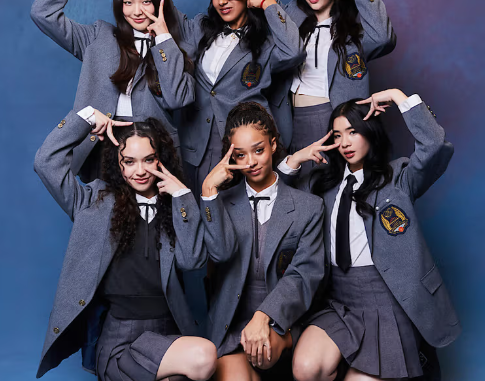
By Eden Lawrence
Sophia, Lara, Yoonchae, Megan, Daniela, and Manon: six girls that make up the new global girl group KATSEYE that claimed their spots on the pop charts with their first EP, Soft is Strong. Before that, however, they had to endure an intense competition show called “The Debut: Dream Academy” that would lead to them forming as the first “global” girl pop group. The group is ethnically diverse with the six girls having culture from the Philippines, India, America, Switzerland, China, and South Korea. Yet while the girls in the group represent a vast variety of cultures, the casting process still seemed extremely selective.
HYBE Entertainment and Geffen Records, who are known for popular K-Pop groups such as BTS, BOYNEXTDOOR, and NewJeans, would work together to make “The Debut: Dream Academy.” A whopping 120,000 applications from around the globe were sent in and ultimately narrowed down to 20 girls who would compete in the show, with the goal of taking the “K” out of K-Pop. They wanted to make a group that would share similar training regimes and practices to K-Pop, but make it a global experience. This would put a lot more emphasis on choreography when performing.
The contestants would go through three stages with a handful of girls being eliminated after each one. The eliminations would be decided by judges’ evaluation of their performance and fan voting. The stages would consist of song and dance routines from famous artists and groups such as LE SSERAFIM, BLACKPINK, Billie Eilish, and the Pussycat Dolls. After the third stage, 10 girls would be left and would do two final performances during the live finale. More fan voting would occur alongside a judging panel to see which six out of the 10 would form KATSEYE.
As a reality TV fan and enjoyer of music, I like the concept of building a music group through training and competition, but I find the lack of skin tone diversity between contestants a bit jarring, especially if the goal is to make a global girl group. HYBE and Geffen said that they received around 120,000 applicants, but out of the 20 that made it onto the show only four had brown or black skin. To make matters worse, these four contestants had very light complexions. The shade range displayed was extremely limited.
This caused some emotion among the contestants. Ezrela Abraham, one of the participants, expressed that she felt put in competition against Lara because they were both Indian. She even predicted that if Lara were to make the group she would not be in it, not believing they would put two brown girls in the final group. This prediction rang true during the finale where Ezrela did not seem phased about not being chosen. She had expressed during the show that if she was not chosen she would be happy to have that Indian representation in the group from Lara. Even though I am upset at the lack of skin tones, this is not to discredit the ethnic diversity the show did display. The 20 competitors hailed from a variety of countries, ranging from Japan to Argentina, Australia to Sweden, and more.
I have been listening to KATSEYE’s EP nonstop and think every member brings a unique sound to the group. “Debut” and “Touch” are standouts for me as I tend to gravitate towards more upbeat music. The latter has garnered a lot of attention on TikTok with its catchy chorus and infectious dance routine. The group’s success continues to rise as they are currently doing performances in Asia. From Sept. 12–16, they’re performing in South Korea, the Philippines Sept. 17-19, and Japan Sept. 20-23.
HYBE and Geffen did great with selecting a talented cast, but it just seems they did not try hard enough to make the show as global as it could have been. With 120,000 applicants I am sure there were talented dark-skinned artists that hoped to make their idol dreams become a reality. If they choose to do another cycle of this show, whether they form another girl group or have a male cast, I hope they expand on the global aspect of this show. Talent from dark-skinned singers and dancers should not be hidden, it deserves a stage to be seen on.
